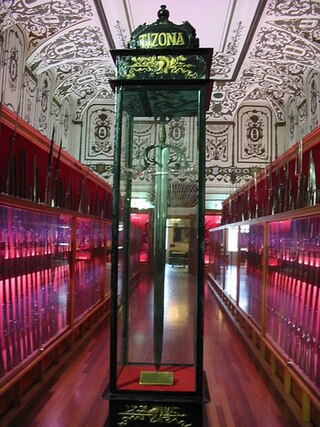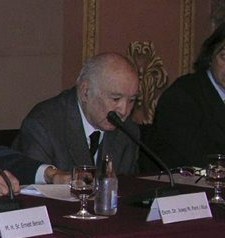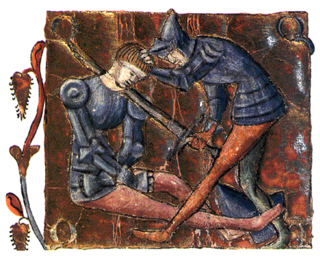
Rodrigo Díaz de Vivar was a Castilian knight and warlord in medieval Spain. Fighting with both Christian and Muslim armies during his lifetime, he earned the Arabic honorific al-sīd, which would evolve into El Cid, and the Spanish honorific El Campeador. He was born in Vivar, a village near the city of Burgos. As the head of his loyal knights, he came to dominate the Levante of the Iberian Peninsula at the end of the 11th century. He reclaimed the Taifa of Valencia from Moorish control for a brief period during the Reconquista, ruling the principality as its Prince from 17 June 1094 until his death in 1099. His wife, Jimena Díaz, inherited the city and maintained it until 1102 when it was reconquered by the Moors.

El Cantar de mio Cid, or El Poema de mio Cid, also known in English as The Poem of the Cid, is the oldest preserved Castilian epic poem. Based on a true story, it tells of the deeds of the Castilian hero Rodrigo Díaz de Vivar—known as El Cid—and takes place during the eleventh century, an era of conflicts in the Iberian Peninsula between the Kingdom of Castile and various Taifa principalities of Al-Andalus. It is considered a national epic of Spain.

Tizona is the name of one of the swords carried by Rodrigo Díaz de Vivar, El Cid, according to the Cantar de Mio Cid. The name of the second sword of El Cid is Colada.
Diego is a Spanish masculine given name. The Portuguese equivalent is Diogo. The name also has several patronymic derivations, listed below. The etymology of Diego is disputed, with two major origin hypotheses: Tiago and Didacus.
Fresh Verdicts on Joan of Arc is an anthology of scholarly essays on Joan of Arc. First published by Garland publishing in 1996 (ISBN 0-8153-3664-0), it is 336 pages long.
Ramiro Sánchez of Monzón (1070–1129/1130) was a noble kinsman of the kings of Navarre. In 1104 he was tenente of Urroz, of Monzón between 1104 and 1116, probably of Tudela in 1117 and from 1122 to 1129 in Erro.

The Mocedades de Rodrigo is the name given to a late, anonymous Castilian cantar de gesta, composed around 1360, that relates the origins and exploits of the youth of the legendary hero El Cid.

Martí de Riquer i Morera, 8th Count of Casa Dávalos was a Spanish literary historian and Romance philologist, a recognised international authority in the field. His writing career lasted from 1934 to 2004. He was also a nobleman and Grandee of Spain.
Old Spanish, also known as Old Castilian, or Medieval Spanish, was originally a dialect of Vulgar Latin spoken in the former provinces of the Roman Empire that provided the root for the early form of the Spanish language that was spoken on the Iberian Peninsula from the 10th century until roughly the beginning of the 15th century, before a consonantal readjustment gave rise to the evolution of modern Spanish. The poem Cantar de Mio Cid, published around 1200, is the best known and most extensive work of literature in Old Spanish.

Doña Jimena Díaz was the wife of El Cid, whom she married between July 1074 and 12 May 1076, and her husband's successor as ruler of Valencia from 1099 to 1102. The spelling Jimena is a modern Spanish one. In the documents of her time, her name was spelled Ximena and it was then pronounced like “Shimena.”

The Carmen Campidoctoris is an anonymous medieval Latin epic poem, consisting of 32 accentual-syllabic Sapphic stanzas, for a total of 128 lines, with one line from an unfinished thirty-third. It is the earliest poem about the Spanish folk hero El Cid Campeador, and was found in the monastery of Santa Maria de Ripoll in the 17th century, after which it was transferred to the Bibliothèque nationale de France where it currently resides as manuscript lat. 5132.
Toledo steel, historically known for being unusually hard, is from Toledo, Spain, which has been a traditional sword-making, metal-working center since about the Roman period, and came to the attention of Rome when used by Hannibal in the Punic Wars. It soon became a standard source of weaponry for Roman legions.

The Battle of Bairén was fought between the forces of Rodrigo Díaz de Vivar, also known as "El Cid", in coalition with Peter I of Aragon, against the forces of the Almoravid dynasty, under the command of Muhammad ibn Tasufin. The battle was part of the long Reconquista of Spain, and resulted in a victory for the forces of the Kingdom of Aragon and the Kingdom of Valencia.
Diego Fernández, also known as Diego Fernández de Oviedo, was a member of one of the most noble lineages of the Kingdom of León as the son of Fernando Flaínez and Elvira Peláez, daughter of count Pelayo Rodríguez. He was the second cousin of King Ferdinand I since both shared the same great-grandfather, Count Fernando Bermúdez de Cea. Distinguished with the title of Count at an early age, Diego was the father of Jimena Díaz, wife of Rodrigo Díaz de Vivar El Cid.
Fernando Flaínez was a powerful magnate from the Kingdom of León, member of the aristocratic lineage of the Flaínez. His parents were Flaín Muñoz and his wife Justa Fernández, daughter of count Fernando Bermúdez de Cea. He was the paternal grandfather of Jimena Díaz, wife of Rodrigo Díaz de Vivar El Cid, and the direct ancestor of the important medieval noble lineage of the Osorios. He married Elvira Peláez, daughter of Pelayo Rodríguez and Gotina Fernández de Cea, with whom he had at least seven children: Flaín, Oveco, Justa, Pedro, Pelayo, Muño and Diego. He was the tenente of Aguilar and documented with the title of count as of 1028. Jointly with his son, Flaín Fernández, he governed the city of León until 1038 when the kingdom was already under the control of King Sancho III of Pamplona.
María Rodríguez (1080-1105) was countess consort of Barcelona.

The castle of Alcocer was a fortified Muslim village located in the archaeological site of La Mora Encantada in the Aragonese municipality of Ateca, Zaragoza, Spain.

The Way of El Cid is a cultural and tourist route that crosses Spain from the northwest to the southeast, from Castilla to the Mediterranean coast. It follows the history and the legend of Rodrigo Díaz de Vivar, El Cid Campeador, a medieval knight of the 11th century and one of Spain’s greatest characters. El Cid is not only a literary character, also a historical figure.
Cristina Rodríguez was a daughter of Rodrigo Díaz also known as El Cid and Jimena Díaz.











